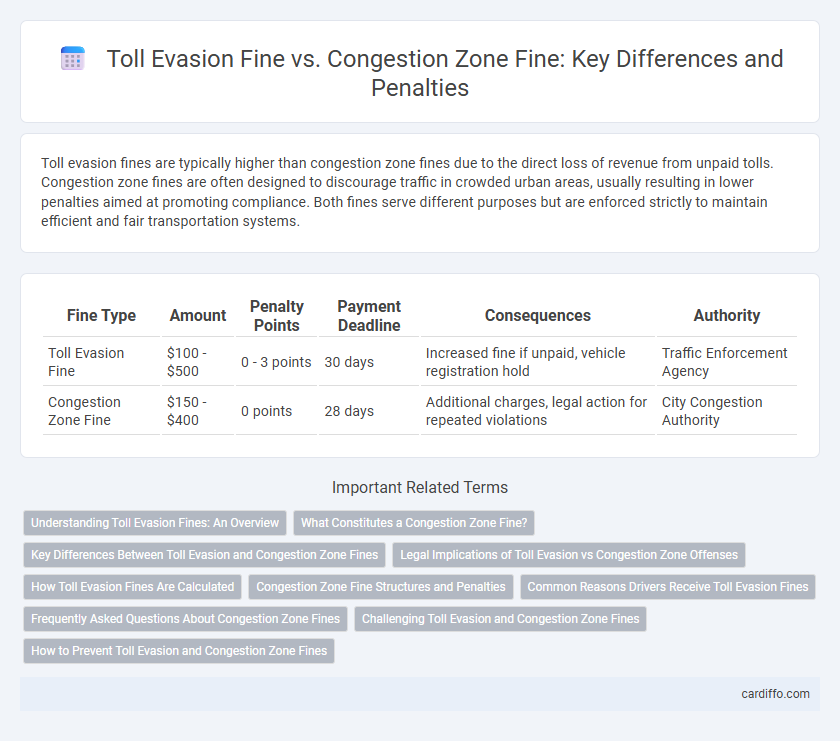Toll evasion fines are typically higher than congestion zone fines due to the direct loss of revenue from unpaid tolls. Congestion zone fines are often designed to discourage traffic in crowded urban areas, usually resulting in lower penalties aimed at promoting compliance. Both fines serve different purposes but are enforced strictly to maintain efficient and fair transportation systems.
Table of Comparison
| Fine Type | Amount | Penalty Points | Payment Deadline | Consequences | Authority |
|---|---|---|---|---|---|
| Toll Evasion Fine | $100 - $500 | 0 - 3 points | 30 days | Increased fine if unpaid, vehicle registration hold | Traffic Enforcement Agency |
| Congestion Zone Fine | $150 - $400 | 0 points | 28 days | Additional charges, legal action for repeated violations | City Congestion Authority |
Understanding Toll Evasion Fines: An Overview
Toll evasion fines are penalties imposed when drivers fail to pay required fees for using toll roads, often calculated based on the unpaid toll amount plus additional administrative charges. These fines aim to ensure compliance and cover the costs of road maintenance funded by toll revenue. In contrast, congestion zone fines target vehicles entering designated urban areas during peak times without appropriate permits, focusing on reducing traffic congestion and improving air quality.
What Constitutes a Congestion Zone Fine?
A Congestion Zone Fine is issued when drivers enter a designated urban area with high traffic density without paying the required congestion charge. This fine aims to reduce traffic congestion and pollution by discouraging unnecessary vehicle access during peak times. Unlike toll evasion fines that relate to unpaid road tolls on highways, congestion zone fines specifically target unauthorized access to controlled city zones.
Key Differences Between Toll Evasion and Congestion Zone Fines
Toll evasion fines primarily target drivers who avoid paying required fees on toll roads, with penalties varying based on the toll amount and jurisdiction regulations. Congestion zone fines focus on vehicles entering restricted urban areas during peak hours without proper authorization, aiming to reduce traffic and pollution. Unlike toll fines, congestion charges are usually time-specific and linked to environmental policies rather than road maintenance funding.
Legal Implications of Toll Evasion vs Congestion Zone Offenses
Toll evasion fines typically carry stricter legal consequences due to direct financial loss and potential criminal charges, whereas congestion zone fines often result in administrative penalties aimed at regulating traffic flow and environmental impact. Toll evasion may lead to prosecution, higher penalty fees, and impact on driving records, while congestion charges focus on compliance and deterrence without criminal liability in most jurisdictions. Understanding these distinctions is critical for drivers to navigate the legal frameworks and avoid escalating penalties in urban traffic management systems.
How Toll Evasion Fines Are Calculated
Toll evasion fines are typically calculated based on the toll amount owed, multiplied by a penalty factor set by local authorities, often ranging from two to five times the original toll fee. The calculation may also include administrative fees and additional charges for repeated offenses, increasing the total fine substantially. In comparison to congestion zone fines, which are usually fixed or vary by time and vehicle type, toll evasion fines directly relate to the unpaid toll amount plus statutory penalties.
Congestion Zone Fine Structures and Penalties
Congestion zone fines are structured to discourage unauthorized vehicle entry into urban areas with traffic restrictions, often involving higher penalties compared to general toll evasion fines due to their impact on city congestion and pollution. Penalties for congestion zone violations typically include fixed fines ranging from $100 to $500 per offense, with increased amounts for repeated violations and potential additional fees for delayed payment. Enforcement relies on automated number plate recognition technology, ensuring accurate identification and consistent application of fines within designated congestion zones.
Common Reasons Drivers Receive Toll Evasion Fines
Toll evasion fines commonly arise from drivers failing to pay toll fees due to expired or missing electronic transponders, incorrect vehicle registration details, or neglecting manual payment options at toll booths. These infractions differ from congestion zone fines, which typically target unauthorized entry or non-compliance with congestion pricing rules. Understanding the specific causes of toll evasion helps in addressing frequent violations and reducing penalty incidences.
Frequently Asked Questions About Congestion Zone Fines
Congestion zone fines are imposed on vehicles entering designated urban areas without paying the required fee, aiming to reduce traffic and pollution. Unlike toll evasion fines, which target unpaid charges on highways or bridges, congestion fines focus on discouraging unnecessary city driving during peak times. Penalties vary by location but often include significant monetary charges and points on the driver's license, highlighting the importance of compliance.
Challenging Toll Evasion and Congestion Zone Fines
Challenging toll evasion fines requires precise evidence such as accurate vehicle identification and proof of payment, often complicated by automated camera errors or rental car disputes. Congestion zone fines involve scrutinizing the validity of entry timestamps and exemption criteria, including medical or resident permits, which can be complex to verify. Both types of fines demand thorough legal understanding of local regulations and strong documentation to effectively contest charges.
How to Prevent Toll Evasion and Congestion Zone Fines
To prevent toll evasion and congestion zone fines, ensure timely payment through official apps or at designated payment points, keeping vehicle registration details accurate and updated. Utilize electronic tags or automated payment systems linked to your account to avoid missing charges and reduce risks of penalties. Regularly review travel routes for congestion zones and toll areas to plan compliant journeys, minimizing exposure to fines.
Toll Evasion Fine vs Congestion Zone Fine Infographic

 cardiffo.com
cardiffo.com